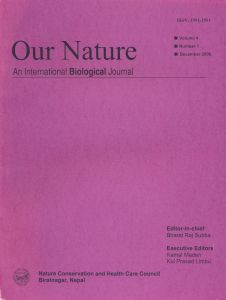Modeling Phosphorus Utilization by Biotic Components: A Test Case Using Two Insoluble Phosphate Sources
DOI:
https://doi.org/10.3126/on.v4i1.497Keywords:
Chironomid larvae, Chlorella, Fish, Phosphorus model, ZooplanktonsAbstract
Natural resource management for sustainable development is urgently required in our society and an adequate model is required for quantification of function of natural ecosystem. A simplistic approach has been tried here to quantify phosphorus utilization by biotic components. Two laboratory experiments were conducted to evaluate the amount of P utilization from two different types of sparingly soluble phosphate rock by aquatic biotic communities. The first type was Mussoorie Phosphate Rock or MPR (sedimentary in origin) and other was Purulia Phosphate Rock or PPR (igneous in origin). The two trials were with eight different treatment combinations. Among various treatments, fish and Chironomid larvae contributed to some extent in increasing the available sediment phosphate content, which in turn increased the soluble reactive phosphate (SRP) of overlying water. The SRP of overlying water decreased in the treatment with zooplanktons. Depletion of SRP of overlying water due to uptake of orthophosphate by Chlorella was also observed. The sedimentary type phosphate rock proved to be more efficient in releasing phosphate than igneous type.
Keywords: Chironomid larvae, Chlorella, Fish, Phosphorus model, Zooplanktons
10.3126/on.v4i1.497
Our Nature Vol.4(1) 2006 pp1-9
Downloads
Downloads
How to Cite
Issue
Section
License
This license enables reusers to distribute, remix, adapt, and build upon the material in any medium or format for noncommercial purposes only, and only so long as attribution is given to the creator.




